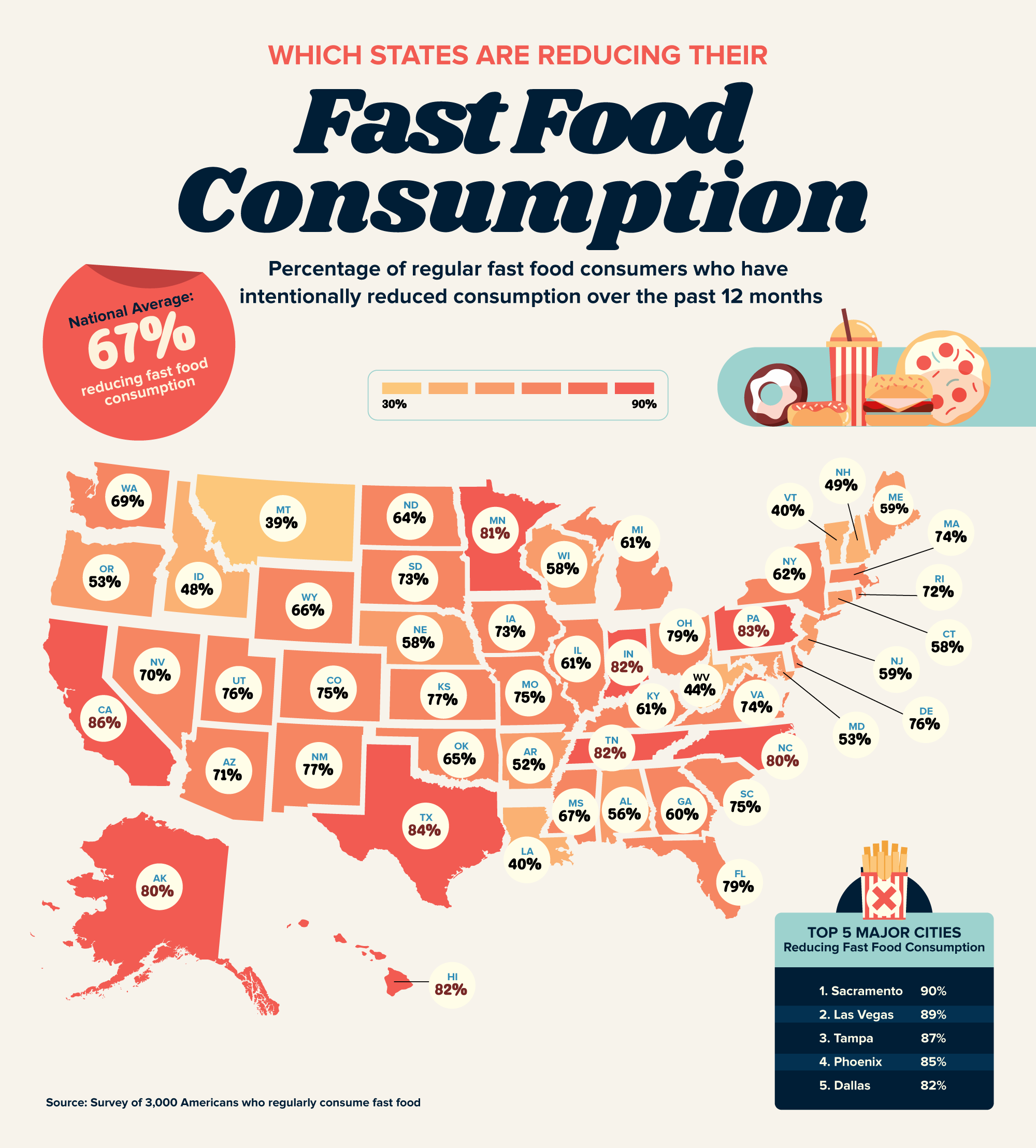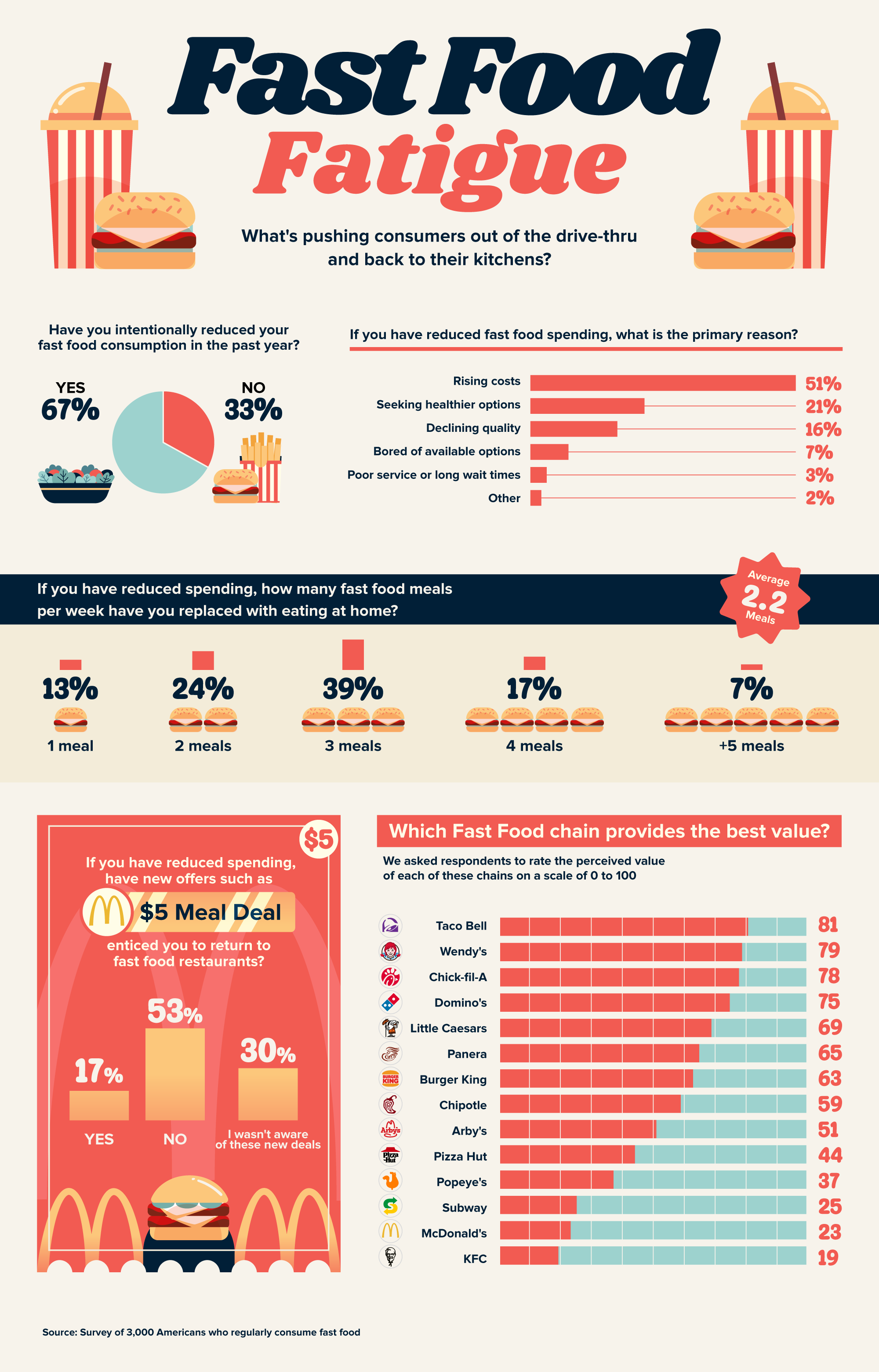Fast Food Fatigue: What’s pushing consumers out of the drive-thru and back to their kitchens?
Have you noticed that fast food chains have been having a bit of an existential crisis lately? Rampant fast food price inflation has rendered what was once an affordable option inaccessible for many Americans, pushing cost-conscious customers out of drive-thru lines. What’s pushing consumers out of the drive-thru and back to their kitchens?
In response, fast food chains have returned to (arguably) what they do best: a value meal. To lure customers back in, burger titans McDonald’s, Wendy’s, and Burger King all brought back a $5 meal deal this summer, with many other chains such as KFC and Taco Bell creating bargains of their own.
But for now, these deals are limited time offerings, and remaining menu items stay at high price points. So are chains doing enough to combat the impending fast food fatigue? We conducted a study of American fast food lovers to get to the bottom of customer sentiment toward the fluctuating fast food marketplace.
Key findings
- Nationwide, 67% of regular fast food diners have intentionally reduced their consumption in the past year
- Residents of California (86%), Texas (84%), and Pennsylvania (83%) are avoiding fast food at the highest rate
- 51% of those cutting back on the drive-thru lane are doing so due to rising costs, compared to 21% for health reasons, and 16% for declining quality
- Consumers rate Taco Bell and Wendy’s as offering the most bang for their buck, while McDonald’s and KFC rated least favorably
Abandoning the drive-thru, dining in indefinitely
Two-thirds of Americans have cut back on fast food consumption in the past year, according to our data. Their reasoning? It’s simply too expensive. Customers tend to feel the tug on their wallets when prices are increased at nearly double the rate of national inflation, as fast food chains have.
Over half of fast food lovers cite rising costs as deterrents, but seeking healthier alternatives (21%) and a perceived decline in food quality (16%) were also major concerns. When prices are up, it’s harder for customers to justify an option they know is unhealthy – the convenience isn’t enough of a draw, considering the fast casual and meal kit options also available to feed busy Americans.

Fast food chains, be warned – your loyal customers are increasingly opting for dining at home. On average, customers reported swapping 2.2 meals per week from fast food to home cooking. What’s more: 63% reporting skipping at least 3 weekly fast food meals in the last year.
That’s a potential loss of billions if the companies don’t course correct.
But at least they’re attempting to. This summer, major fast food chains competed to provide the most enticing $5 meal deal for customers. McDonald’s, Wendy’s, Burger King, KFC, Taco Bell, Pizza Hut, White Castle, and even Starbucks all vied for our affections, but for many, the deals simply weren’t cutting it.
Over half of frequent fast foodies (53%) weren’t enticed enough by the deals to return, and 30% weren’t even aware of them. Only 17% of fast food lovers reported trying out the deals.
Maybe chains need to instead focus on their ability to provide consistent value, because many of their reputations are in jeopardy. When asked which chains provide the best value, customers ranked Taco Bell, Wendy’s, and Chick-fil-A at the very top, while Subway, McDonald’s, and KFC seem to not give them their money’s worth.
Which states are cutting back on fast food?
Fast foodies are abstaining nationwide, but states like California (86%), Texas (84%), and Pennsylvania (83%) are leading the charge. Hawaii and Indiana also show significant drops, with 82% of regular consumers in both states intentionally scaling back their drive-thru visits in the last year.

Some states are shifting their habits much less dramatically. Arkansas (52%), Idaho (48%), and Louisiana (40%) show lower rates of reduction, and Montana reports the lowest rate of reduction at 39%.
However, major cities reflect even steeper declines in fast food consumption, with Sacramento topping the list at a staggering 90% of residents cutting back. Las Vegas (89%), Tampa (87%), and Phoenix (85%) closely follow, while Dallas rounds out the top five at 82%.
These urban area cutbacks may be driving a larger cultural shift away from fast food and toward healthier options with comparable pricing, such as fast casual restaurants or meal delivery services.
Checking out the future of fast food
Fast food’s recent identity crisis didn’t come out of thin air. Customers are increasingly choosing more affordable home-cooked meals, or healthier grab and go alternatives, leaving fast food chains with the challenge of redefining their value proposition in a highly competitive market.
As fast food chains look ahead, they’ll need to do more than offer temporary deals. Consistency will need to be the key to bringing loyal customers back. If chains fail to adapt, customers might end up leaving the drive-thru in their rearview mirror for good.
Methodology
This survey was conducted in September 2024 utilizing a pool of 3,000 Americans who regularly consume fast food. The median age of the respondents was 37. Gender distribution was 53% men, 45% women, and 2% other gender identities.
Fair Use
Interested in sharing this data? Feel free to use any of the information or graphics above for noncommercial purposes. Please be sure to provide linked attribution to this page in your article.
